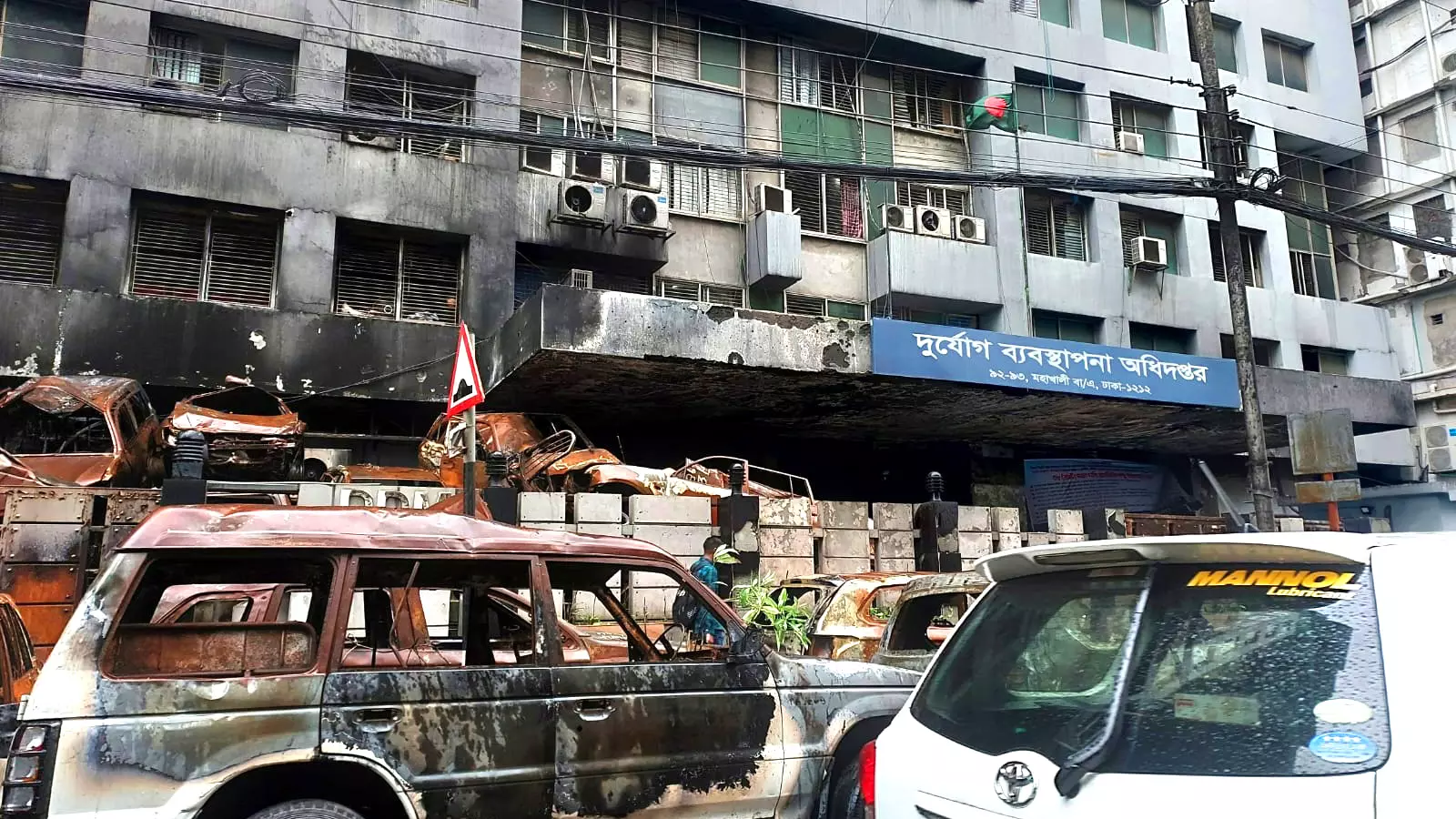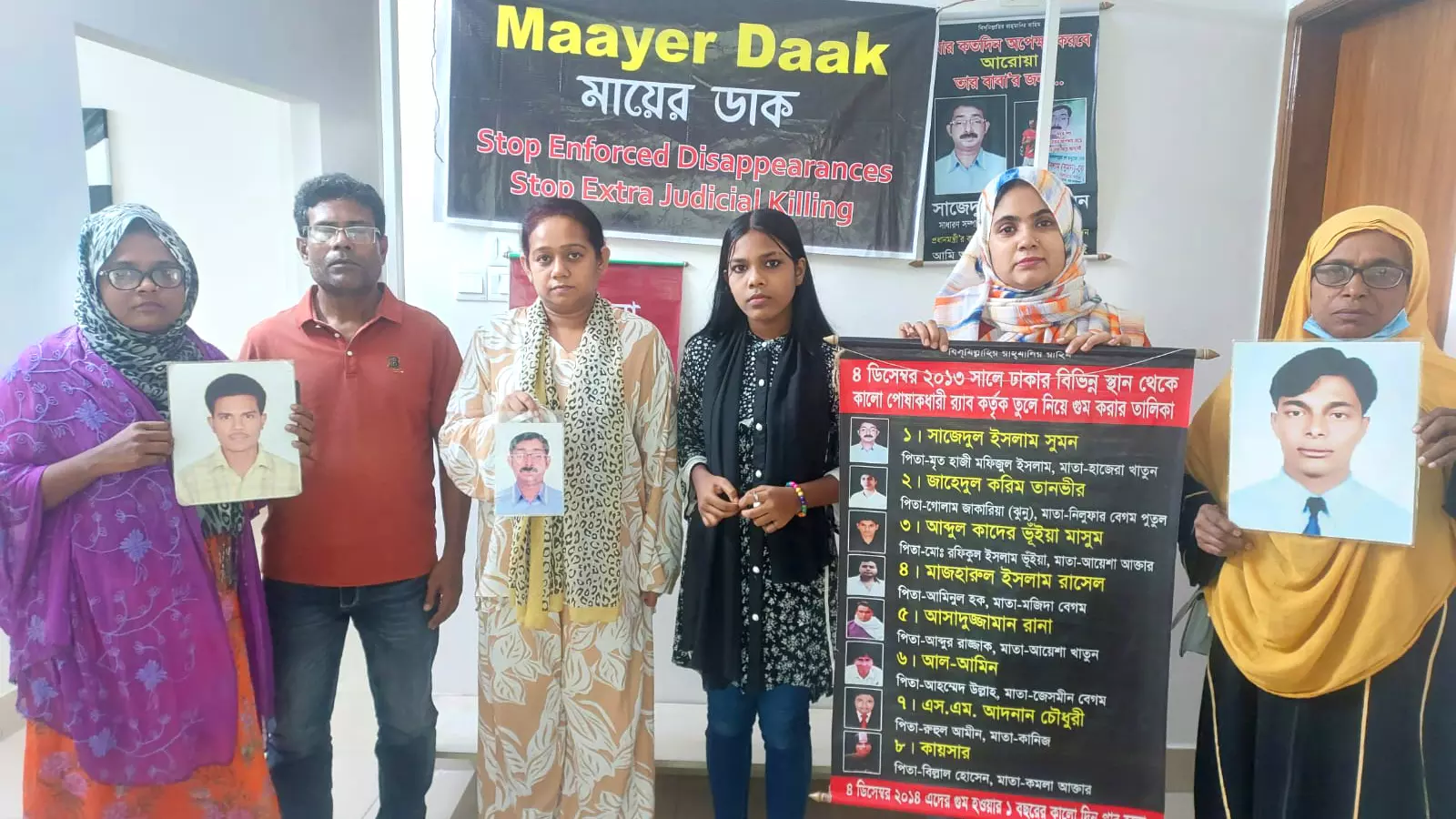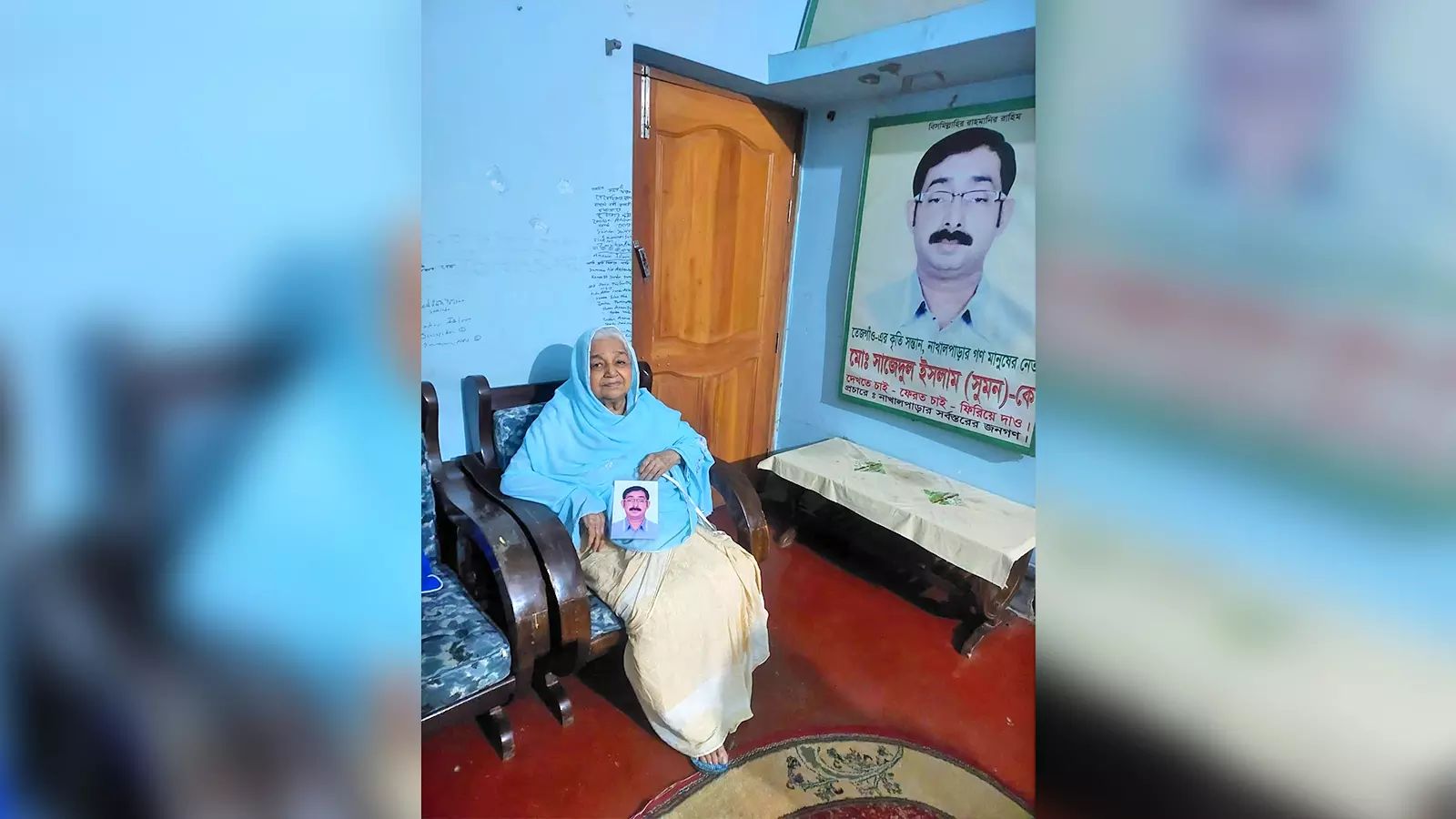
- Home
- India
- World
- Premium
- THE FEDERAL SPECIAL
- Analysis
- States
- Perspective
- Videos
- Sports
- Education
- Entertainment
- Elections
- Features
- Health
- Business
- Series
- In memoriam: Sheikh Mujibur Rahman
- Bishnoi's Men
- NEET TANGLE
- Economy Series
- Earth Day
- Kashmir’s Frozen Turbulence
- India@75
- The legend of Ramjanmabhoomi
- Liberalisation@30
- How to tame a dragon
- Celebrating biodiversity
- Farm Matters
- 50 days of solitude
- Bringing Migrants Home
- Budget 2020
- Jharkhand Votes
- The Federal Investigates
- The Federal Impact
- Vanishing Sand
- Gandhi @ 150
- Andhra Today
- Field report
- Operation Gulmarg
- Pandemic @1 Mn in India
- The Federal Year-End
- The Zero Year
- Science
- Brand studio
- Newsletter
- Elections 2024
- Events
Bangladesh fights to find those forced to disappear by Sheikh Hasina’s regime

It was the midnight of August 6. Just a day ago, Bangladesh experienced a seismic change in its polity.Prime Minister Sheikh Hasina Wazed was forced to leave the country in the face of a mass uprising to bring down what was seen as a “fascist regime” in Bangladesh’s popular perception. Hopes dashed Nothing perhaps could lend more credence to the perception than the presence of hundreds...
It was the midnight of August 6. Just a day ago, Bangladesh experienced a seismic change in its polity.
Prime Minister Sheikh Hasina Wazed was forced to leave the country in the face of a mass uprising to bring down what was seen as a “fascist regime” in Bangladesh’s popular perception.
Hopes dashed
Nothing perhaps could lend more credence to the perception than the presence of hundreds of despairing family members in front of the DGFI office inside Dhaka cantonment on that momentous midnight frantically seeking information about their missing relatives.
The DGFI is the acronym for the Directorate General of Forces Intelligence, the spy agency of the Bangladesh armed forces.
The agency was allegedly running secret internment facilities to lodge opposition leaders and critics of Hasina’s Awami League government without any legal sanction or even acknowledging their presence—a curtailment of liberty generally known as enforced disappearance.
The relatives thronged there were finally seeing some flicker of hope of finding their loved ones or at least getting some information about them.
By then news of the sudden returning home of suspended brigadier general Abdullahil Amaan Azmi and Supreme Court lawyer Mir Ahmad Bin Quasem had gone viral.
Azmi, son of late Jamaat leader Ghulam Azam, and Ahmad, son of executed Jamaat leader Mir Quasem, had ‘disappeared’ eight years ago.
“We ran to the DGFI headquarters after getting to know about the release of the two missing persons... Definitely, we were very hopeful. After all, the fascist regime was toppled. But at the end, we returned disappointed,” said daughter of Chowdhury Alam, the then Dhaka City Corporation ward-56 commissioner and national executive committee member of the main opposition — the Bangladesh Nationalist Party (BNP).
“We stood there from 12 midnight to 3 am frantically seeking information about my father. There was no cooperation, much less any information,” she said with moistness in her eyes and lumps in her voice.
It was a 14-long-year wait that would finally end, she and her other relatives thought as they dashed to the DGFI office.
There were many other people like us pleading to know about the fate of their fathers, husbands, brothers or sons.
The enforced disappearances
Alam was whisked away from Dhaka’s Farmgate area by some six to seven unidentified men at about 8 pm on June 25, 2010, barely over a year after the Awami League came to power.
The family was since then in complete darkness about his whereabouts.
“He had stopped staying in the house fearing harassment or arrest by the police ahead of a countrywide dawn-to-dusk hartal called by the BNP for June 27. On that ill-fated day, he had briefly come home in the evening and that was the last time I saw him. He offered namaz and hurriedly left around 6 pm,” said Alam’s wife Hasina Chowdhury.
“Incidentally, police had earlier come looking for him on that very day. At that time, he was not at home,” she recalled.
Later, late in the evening Chowdhury’s car driver Asim Chandra Bhowmik called the family to inform them about the ‘abduction’.
As per the driver’s version, Alam was going from a relative's house on the capital's Indira Road to Dhanmondi. A microbus waylaid the car and dragged the BNP leader into it.
There were six to seven people, Asim told the family. The attackers also assaulted him before driving off with the car (Dhaka Metro-Ga 23-3516), leaving him behind. The car was found abandoned at the city’s Karwanbazar a day after the incident.

Vehicles that were set ablaze by protesters in Bangladesh. The fires have died out since but families whose members have been 'missing' are yet to find peace and closure. Photos: Samir K Purkayastha
Several newspapers reported that Alam was arrested in connection with the BNP’s June 27 hartal.
“The police later feigned ignorance about the arrest and even refused to accept a case when we went to the Tejgaon police to file a general diary,” said his daughter.
The family suspects involvement of the Rapid Action Battalion (RAB), the anti-crime and anti-terrorism unit of the Bangladesh Police.
The suspicion stemmed from an earlier incident. A group of people riding on three motorcycles tried to pick-up Alam from the capital’s Gulshan area in the evening of June 20, his wife recalled.
As per the media report of that time, when the Gulshan police was informed about the incident, the men were detained. One of them identified himself as Belayet from RAB's intelligence wing.
The RAB had then denied its involvement to the media about.
“You see, we have reasons to suspect the involvement of the RAB. Moreover, the way police were behaving, it was clear they were trying to hide something. Initially, a police officer even verbally assured us that my father would come back in a day or two,” the daughter said. “Instead, of looking for him, the police started harassing us. They would strangely come and search our house looking for my missing father.”
“We thought it was a preventive detention ahead of the BNP’s programme and he would be released after that,” Hasina chipped-in to add.
That never happened.
It was not a one-off case. A leading human rights group of Bangladesh, Odhikar, logged cases of 709 people who had allegedly become victims of enforced disappearance between 2009 and June 2024.
As per the statistics of the rights body, 240 people were picked up by the Detective Branch of police, 206 people by the RAB, 104 by the police and nine by the DGFI. In 129 cases, the identity of the agency that was involved could not be ascertained.
The police's Criminal Investigation Department, Ansar, and Industrial Police were also involved in some cases, it was alleged.
Human Rights Watch, in its 2021 report, claimed that security forces committed over 600 enforced disappearances since Hasina came to power in 2009.
Among the victims were a former member of parliament, retired diplomat, former army officer, lawyer, politicians, human rights activist, labour leader and even a musician apart from leaders and ordinary workers of the opposition parties, mainly the BNP.
The Awami League government had persistently denied incidents of enforced disappearance, dismissing them as a canard to malign the regime.
“Upon investigation of the alleged enforced disappearance cases, it came to the fore that people often disappear voluntarily to avoid legal action for cases lodged against them. Sometimes they choose to disappear due to family feud or to avoid business liability, and some often willingly disappear with the intention of embarrassing the government,” the previous dispensation claimed in a communique to the UN on May 12, 2022.
House of horrors
The truth started tumbling out as a few lucky ones who could walk out of the detention facilities after the ouster of the Hasina government have narrated blood-cuddling tales of their experiences inside the dungeons, fabled as Aynaghar, or “house of mirrors”.
The facilities got the cryptic title as a detainee could not see anyone except himself, just as in a mirror.
“It was like being confined in a graveyard. In the five years of my confinement, I did not get the chance to see the sunlight or have some fresh air. There was also no chance of seeing another human being. Even the guards used to cover their face… Complete cut off from the rest of the world. Only at times I could hear the sound of aazan or screams of fellow prisoners. But even the outside sound used to be drowned out by a noisy fan. The fan was installed in the small room as a torture device, and not to circulate air,” recalled Michael Chakma, the spokesperson of a tribal political party called United People’s Democratic Front.
He was particularly vocal against atrocities committed by the army on indigenous tribal population in the remote Chittagong Hill Tracts in southern Bangladesh.
Chakma was released a day after Hasina’s government was overthrown.
In captivity, he was completely unaware of the mass uprising and hence could not believe he would actually be freed when guards told him so. His confinement was so total that he did not even get to know about the Covid pandemic, raging the outside world.
Azmi, another of the three detainees released after the regime change, narrated a similar experience.
“I was not allowed to see the light of the day. It was complete darkness. Even the ventilator in the room was sealed,” he said in a video posted on social media after his release.

Relatives of the victims at the Maayer Daak office.
The existence of Aynaghar first came to light when Netra News, a Sweden-based news portal, reported in August 2022 about the facility inside the military cantonment in the heart of Dhaka.
Fighting to find those lost
A delegation of rights activists, led by Mayer Daak, called on the Director General of the DGFI on August 6. The delegation was told that the DGFI has 23 facilities. But whereabouts of the facilities and whether there was any detainee were not disclosed.
Mayer Daak (mothers’ call) is the platform of the victim families. It is named after the Argentine platform Mothers of the Plaza de Mayo formed in late 1970s to help families search for their children who disappeared under the country's military government that seized power in a coup in 1976.
Mayer Daak co-founder Sanjida Islam Tulee expressed her disappointment with the lack of cooperation from the security agencies in revealing information of the victims.

Mother of Suman and Mayer Daak co-founder Tulee. Suman is still missing.
The same officers who were responsible for running the detention facilities are still holding important positions and they must be putting pressure on the government against unearthing the whole truth about the enforced disappearance, she alleged.
Her own brother Sajedul Islam Sumon, a local BNP leader was picked up from Bashundhara residential area of Dhaka on December 4, 2013, and since then there has been no trace of him.
The change of government did not so far help ease the pain of those families, who are still hoping to get at least some information whether their near ones are dead or alive.
“We are committed to go to the bottom of it. Maybe some evidence is destroyed so it is taking some time to unravel the entire truth. There is no pressure from any quarter to hold us back,” Nahid Islam, Information and Broadcasting adviser and spokesperson of Bangladesh’s interim government, told The Federal.
Three weeks after the new government assumed charge it formed a five-member inquiry commission to identify and find the missing people.
But a recent army raid at the office of the Mayer Daak in Dhaka’s Shaheenbag area showed that the government might have changed but not the ways of the rulers.
